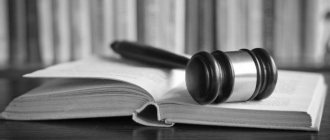New edition of Art. 88 Code of Criminal Procedure of the Russian Federation
1. Each evidence is subject to assessment from the point of view of relevance, admissibility, reliability, and all collected evidence in the aggregate - sufficiency to resolve the criminal case.
2. In the cases specified in part two of Article 75 of this Code, the court, prosecutor, investigator, inquirer recognizes the evidence as inadmissible.
3. The prosecutor, investigator, or interrogating officer has the right to declare evidence inadmissible at the request of the suspect, accused or on his own initiative. Evidence declared inadmissible shall not be included in the indictment, indictment or indictment.
4. The court has the right to declare evidence inadmissible at the request of the parties or on its own initiative in the manner established by Articles 234 and 235 of this Code.
Article 74 of the Code of Criminal Procedure of the Russian Federation. Evidence (current edition)
1. The content of evidence is any information with the help of which circumstances that are subject to proof in criminal proceedings can be established (Article 73), as well as other circumstances relevant to the criminal case. It seems that the term “information” in the definition of evidence indicates that evidence is not initially considered as facts, i.e. definitely reliable information. They are subject to review by the court and the parties and may be assessed differently. In other words, the reliability of information is not a necessary feature of evidence - the information contained in the evidence may indicate the circumstances sought in the case and with probability. As a rule, a conclusion about the reliability of this information can be made only after a final assessment of a certain body of evidence. In addition, information is information received only from a person. This means that the source of evidence is always one person or another. This conclusion is especially important for the concept of physical evidence. See comment. to Art. 81 of this Code.
2. According to the definition of evidence given in Part 1 of the commented article, the circumstances to be proven are established through evidence not only by the court, but also by the prosecutor, investigator and investigator. In other words, information obtained during the preliminary investigation and in court proceedings is equally recognized as evidence in this article. However, one should not assume that all the evidence obtained by the prosecutor, investigator, interrogator, i.e. by the prosecution have equal procedural status with evidence obtained directly in court. So, according to Part 1 of Art. 276 and part 1 of Art. 281, the disclosure of the testimony of a victim and witness who did not appear at the court hearing, given, in particular, during the preliminary investigation, can, as a general rule, only take place at the request and with the consent of the parties. This means that the protocols of interrogations of these persons, obtained, in particular, during the preliminary investigation, usually cannot be disclosed and used in court proceedings on a par with the testimony of defendants, victims and witnesses given directly in court proceedings, if at least one of the parties (in including the defense) objects to this. In other words, the law provides for at least two types of evidence that have unequal legal force, namely evidence collected at the pre-trial stages of the process and judicial evidence itself. See also the comment about this. to Art. Art. 276, 281, 377 of this Code.
———————————
Due to the fact that the prosecutor currently does not have the right to participate in investigative actions, his establishment of the circumstances of the case on the basis of evidence is apparently only possible if he returns the criminal case to the inquirer or investigator with his written instructions on conducting an additional investigation and changing the scope of the charges (p 15, part 2, article 37, clause 2, part 1, article 221, clause 2, part 1, article 226).
3. In part two comment. Articles mention as evidence only the testimony of the suspect, accused, testimony of the victim, witness; conclusion and testimony of an expert, conclusion and testimony of a specialist; material evidence, protocols of investigative and judicial actions and other documents. However, other norms of the Code also include testimony and explanations of the civil plaintiff (clauses 3, 5, part 4, article 44), testimony and explanations of the civil defendant (clauses 3, 5, part 2, article 54), testimony expert with an explanation and addition to the conclusion given by him (Articles 80, 282).
Comment source:
Ed. A.V. Smirnova “COMMENTARY ON THE CRIMINAL PROCEDURE CODE OF THE RUSSIAN FEDERATION” (ARTICLE BY ARTICLE), 5th edition
SMIRNOV A.V., KALINOVSKY K.B., 2009
Classification and functions
The distribution of the data array into categories is conditional and vaguely established by law. There is no unanimous agreement on this matter among scientific theories, since any statement can simultaneously play the role of direct and indirect. And the range of circumstances that are important for establishing the truth is influenced by the subjective factor - the opinion of the investigator, the court.
The most common classification:
- direct - directly indicate the circumstances that need to be proven (for example, a thief comes to confess to the police or the victim talks about who committed the robbery);
- indirect - indicate circumstances that took place before, during and after the event under study. The totality gives grounds to draw specific conclusions about the reality of the offense, the guilt of the suspect, the accused.
The method of developing, verifying, proving or disproving versions based on this information is more time-consuming, complex, requiring significant experience and prudence.
Indirect arguments greatly influence a criminal case:
- extremely important for testing direct evidence;
- often help to establish the motive - the subjective side of the composition, which is the connecting link of the entire complex of collected arguments;
- inform about the intent, psychological portrait of the attacker, and the presence of accomplices;
- fill gaps in versions;
- open ways to attract new information;
- especially affect the disclosure of some complex offenses (bribery, abuse of power, theft, etc.);
- indicate the attitude of the criminal to the crime committed (behavior: desire to mislead law enforcement agencies or, conversely, repentance);
- play a role in crime prevention by establishing the prerequisites underlying them.
During the investigation, depending on the subject of proof, the status of evidence may naturally change.
For example, the presence of a sum in the hands of a citizen at a certain moment can directly prove the giving of a bribe, but indirectly allow an attempt to receive a bribe. We have to admit that indirect arguments are most often significant for establishing guilt.
Similar facts and features of use
A special type, indicating an analogy with a committed unlawful act:
- methods of attack, hacking;
- choice of storage method;
- time;
- characteristics of the victims, etc.
Coincidences indicate that a crime was committed by the same person, or a connection between similar events.
“Such facts” play a key role in solving a series of murders, thefts, frauds, abuses, robberies, and rapes that can drag on for years. The nuance of use: it is impossible, having solved one crime, to condemn a person for a number of other similar atrocities, only based on analogy. Every crime requires a full investigation and a judicial decision.
The work of a detective includes several mandatory stages:
- Detection and clarification of the need to attract additional sources.
- Quality check, admissibility assessment.
- Establishing relevance to the commission of a crime by a specific person.
- Analysis of connections with other evidence.
It is important not only to obtain information, but also to evaluate its quality and establish a connection with the facts being studied.
Detection
To detect, to record - for this it is necessary to take very seriously the collection of data on each element of the composition: object, objective side, subject, subjective side.
Wherein:
- the information must be complete and leave no room for doubt;
- any contradictory arguments or “gaps” may serve as a signal for the need to obtain additional indirect evidence that will confirm or refute the version.
The connection between indirect information and the subject of proof is ambiguous and always contains an assumption. Classic examples of circumstantial evidence in criminal proceedings, to which law enforcement agencies do not pay enough attention, are mentioned in the film “The Meeting Place Cannot Be Changed.” Here the suspect Gruzdev reports that he has branded cartridges for his own personalized pistol, from which a woman was killed. He asks the question: “Why, when committing a deliberate crime, use random cartridges that can misfire?”
The presence of branded cartridges in itself does not disprove guilt, but provides a significant reason for constructing and testing other versions. However, this information initially does not receive close attention from detectives.
Comprehensive analysis, sufficiency
It is impossible to form a full-fledged version based on only one circumstance.
This statement is especially true when working with indirect evidence:
- you need so many arguments that they form a complex objectively sufficient to prove or refute the thesis;
- It is important to evaluate the volume of data only from the point of view of their relationship with each other. The slightest contradiction will indicate poor quality evidence or its incorrect assessment.
- even if the theoretical exclusion of a fact from the entire complex completely destroys the version, it means that the evidence base has been collected correctly.
Often, information containing a direct indication of involvement in a crime against one person acts as an indirect confirmation of the innocence of another.
Thus, when examining the scene of the murder of Larisa Gruzdeva (the feature film “The Meeting Place Cannot Be Changed”), a wine bottle with fingerprints on the glass and a bitten chocolate bar were discovered. The fingerprints and the shape of the bite did not correspond to the anthropometric data of the suspect Gruzdev, which indirectly indicated his possible non-involvement in the crime.
But this evidence directly pointed to the real criminal, Fox, who was later detained. Together with other collected and procedurally established facts, the information created a logical complex that made it possible to save an innocent person from undeserved punishment.
Terms of use
From the features of detection and processing, rules for working with them are formed:
- A definitive conclusion cannot be drawn from indirect evidence alone.
- The information is actually connected with the event being proven and with each other.
- Each intermediate statement is supported by several arguments.
- The totality leads to reliable conclusions.
- Systematized information should produce only an indisputable final conclusion, excluding all other reasoning and any reasonable doubts about the objectivity of the proven circumstances; only in this case will each individual piece of evidence have significance.
Only scrupulous adherence to the rules becomes the key to a high-quality and fair investigation and avoidance of punishment for the innocent.
The Code of Criminal Procedure of the Russian Federation does not classify indirect evidence as a separate group, but in no case are they “second-class” and are not regarded as “optional.” The opinion that an investigation should be based only on direct evidence leads to a formalization of the process. In practice, it is with the help of indirect information that the truth is most often established. When used correctly, with the ability to group and make logical conclusions, they lead to objective conclusions.
Admissibility of evidence if received by an inappropriate subject.
The Code of Criminal Procedure of the Russian Federation strictly defines the circle of subjects authorized to collect evidence in a criminal case.
At the stage of inquiry and investigation, such subjects are: the inquiry officer, the investigator, the prosecutor.
In criminal cases in which a preliminary investigation must be carried out, the investigative body has the right to carry out only urgent investigative actions listed in the law. These investigative actions should be carried out only after the initiation of a case.
After urgent investigative actions have been carried out, the case must be transferred to the investigator. After the case is transferred to the investigator, all investigative and operational-search actions in the case can be carried out by the inquiry body only if there is a written order from the investigator to carry them out.
If, without a written order from the investigator, the body of inquiry carried out any investigative actions, then they are recognized as unacceptable evidence, since they were obtained by an inappropriate subject.
However, if at the time of transfer of the case the person who committed the crime has not been identified, the investigative agency has the right and obligation to continue the operational investigation to identify this person.
In accordance with the norms of the Code of Criminal Procedure of the Russian Federation, to conduct investigative and operational-search actions, the investigator sends a written order to the head of the inquiry agency. He, in turn, must entrust the execution of the investigator’s written instructions to specific operational employees of the inquiry agency. The law does not regulate the procedure for appointing specific executors of the investigator’s instructions, which is incorrect, since without issuing a special decision of the head of the investigative body, it is impossible to establish whether the investigative actions were entrusted to a given operational officer or not, and from here it is impossible to determine whether he is the appropriate subject when conducting investigative and operational intelligence activities. which are entrusted to the body of inquiry by the investigator.






